Mammals of Mount Diablo State Park
by John Pelonio
This list describes the mammals found on Mount Diablo and its foothills. It was compiled using studies conducted in the park, specimens collected by the Museum of Vertebrate Zoology of UC Berkeley and park records and sightings.
Species that may occur but have not been seen
Spotted skunk
Ringtail
Trowbridge Shrew
Bush Mouse
American Badger (updated June 2022)

Drawing by Nathan Crawford
Species probably extinct on Mount Diablo
Heerman's Kangaroo Rat
San Joaquin Kit Fox
Species Extinct on Mount Diablo
Grizzly Bear
Wolf
Tule Elk
Pronghorn Antelope
Grey Squirrel
Carnivores
Mountain Lion or Cougar (rare)
The cougar does occur on Mount Diablo, but is rarely seen. Cougars require such a large range that there may be only one or two cats in the area. Cougars eat mainly deer, but will occasionally take smaller prey or carrion.
Bobcat (occasionally seen)
This shy cat is widespread on Mount Diablo, but is rarely seen by park visitors. Residents of the park often see bobcats in the early morning or evening. Bobcats eat rodents, rabbits, birds, and an occasional deer.
Grey Fox (occasionally seen)
The grey fox is widespread and abundant on Mount Diablo. Foxes are often seen along park roads at night by park residents. Foxes eat rodents, insects and berries.
Coyote (occasionally seen)
Coyotes are abundant on Mount Diablo, but are rarely seen. Campers and park residents often hear them at night. The coyote eats mainly rodents and carrion. Despite its reputation, the coyote rarely kills livestock. It will feed on any dead animal it can find.
Badger (rarely seen)
The badger, thought to be extinct, has been sighted more recently on Mount Diablo. Badgers eat gophers and ground squirrels which they catch by digging them up.
Raccoon (seen regularly)
Raccoons are found throughout the park, especially around water and developed areas. They often steal food from park visitors and get into garbage cans. Their natural diet includes frogs, berries, insects, reptiles, eggs and small mammals.

Bobcat | Brian Murphy
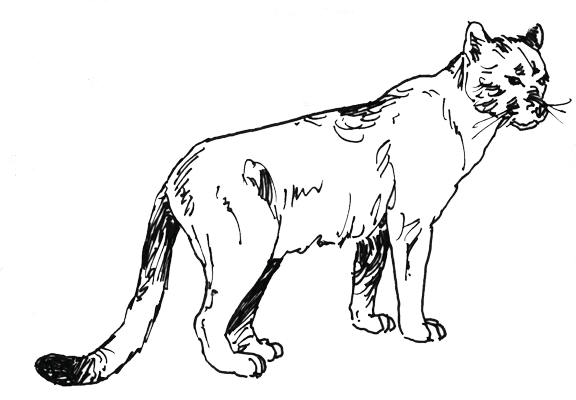
Mountain Lion

Front

Rear
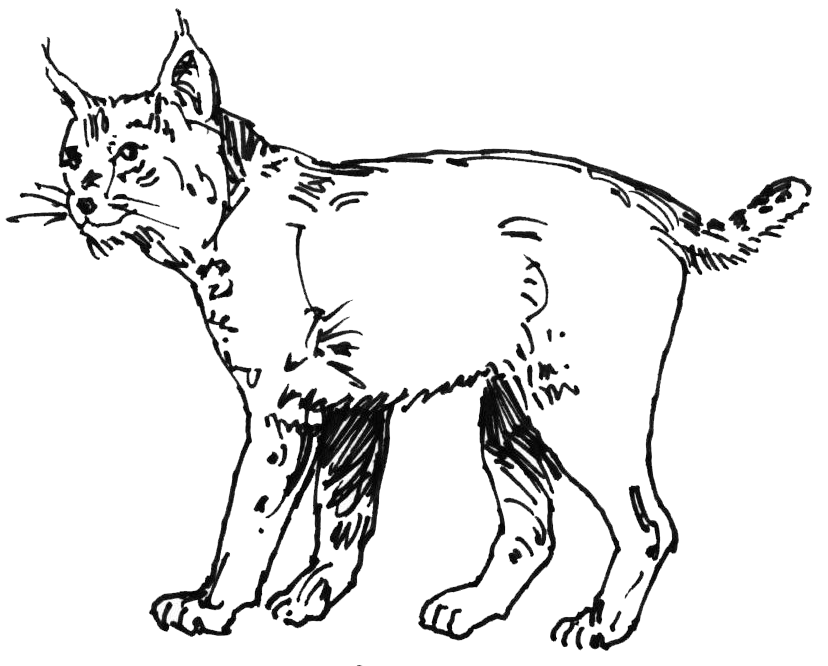
Bobcat
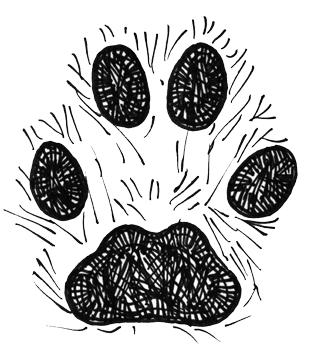

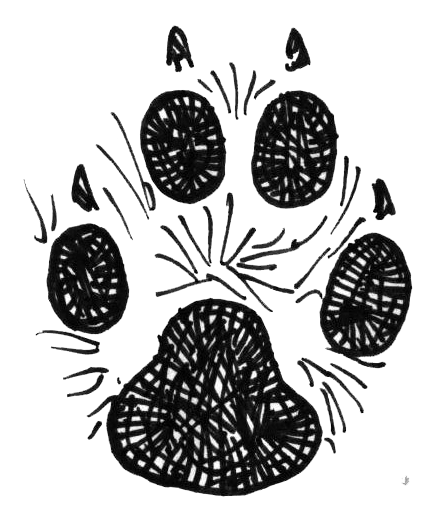
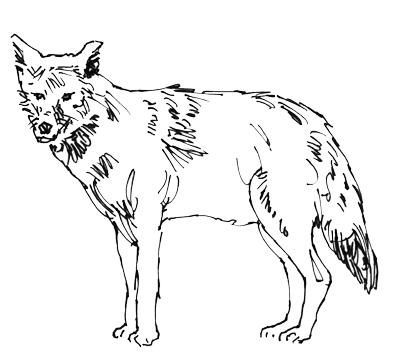
Gray Fox
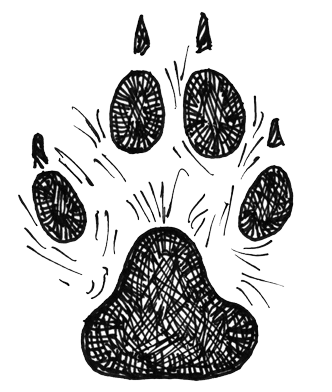
Coyote
| Illustrations by Mike Nelson |
Long Tailed Weasel (rarely seen)
The weasel is very secretive and, therefore, rarely seen. It can go into holes after rodents and rabbits it eats.
Opossum (occasionally seen)
The opossum is our only marsupial or pouched animal. It was introduced into California from the eastern states around the turn of the century. It has now become established all over the state. Opossums will eat anything edible, including carrion, fruits, nuts, rodents, even garbage.
Hoofed Animals
Blacktailed Deer (seen regularly)
Deer are often seen in the morning or evening and when there are few park visitors. They are browsers, feeding on grass, shrubs, herbs and acorns. Deer are preyed upon by mountain lions, bobcats and occasionally coyotes and feral dogs.

Rabbits and Hares
Rabbits and hares feed on grasses, herbs and shrubs. They are are an important food source for bobcats, foxes, coyotes, and eagles. Hares have longer ears and legs than true rabbits, and have young that are born fully furred and able to move around on their own.
Cottontail (seen regularly); Brush Rabbit (seen Regularly)
We have two true rabbits on the mountain, the cottontail and brush rabbit; they are similar in appearance.
Jackrabbit (seen regularly)
The jackrabbit is actually a hare. It is most common in grassland areas, but also found in brushy areas.
Rodents
Rodents occur in large numbers and are a major source of food for such predators as hawks, owls, foxes, bobcats, weasels, coyotes, and snakes.
Old World Rats and Mice
Norway Rat (rarely seen), Roof Rat (rarely seen), House Mouse (rarely seen); these rodents were brought to the New World by ships from Europe. They have since spread to most developed areas of North America. Although they are common throughout most of Contra Costa County, they are not found at the higher elevations of Mount Diablo.
Western Harvest Mouse (rarely seen)
These tiny mice live in grassy areas where they feed mainly on grass seeds.

White Footed Mice
Deer Mouse (occasionally seen), Pinyon Mouse (rarely seen), California Mouse (rarely seen), Brush Mouse (unknown; may not occur in the park). These four mice are closely related. They feed on nuts, berries, seeds and herbs. The deer mouse and California mouse are widespread on Mount Diablo. The pinyon mouse is rare, but has been found on the mountain. The brush mouse may occur, but has not been found on the mountain.
Woodrats
Dusky Footed Woodrat (occasionally seen); Desert Woodrat (rarely seen). These rodents are sometimes called "packrats" because they tend to collect things and store them in their nests. The nest looks like a pile of sticks but contains many passages and rooms. The abandoned passages are used by a variety of other animals. Woodrats eat seeds, nuts, and berries.
California Meadow Mouse (occasionally seen)
The meadow mouse or vole is abundant in the grassland areas of Mount Diablo. Voles make runways through the grass. They feed on grass, seeds, roots, and bark.
California Pocket Gopher (seen regularly)
This gopher, seen throughout Mount Diablo, also digs up lawns and gardens. Gophers feed on roots, grasses, herbs, and seeds.
Fox Squirrel (abundant; seen by most park visitors)
This common red-brown colored squirrel is seen on power lines and trees throughout the bay area. The fox squirrel was introduced into California and has replaced the grey squirrel over much of its range. It was introduced into Mount Diablo State Park in 1960. Grey squirrels, which were abundant on the mountain have not been seen since shortly after the fox squirrels were released.
California Ground Squirrel (abundant; seen by most park visitors)
Ground squirrels are abundant in the developed areas of Mount Diablo. They are so abundant in some areas that they are creating erosion problems and damaging park roads and buildings. Ground squirrels are absent from many of the back country areas, possibly due to the extensive eradication program conducted by the county in the park up to 1974.
Muskrat (unknown; may not occur in the park)
The muskrat was introduced into the Sacramento / San Joaquin Delta and has spread into many of the creeks around Mount Diablo. Muskrats eat mainly cattails, and other plants, but will also eat clams and snails.
Insectivores
Bats (seen regularly)
There are thirteen species of bat which may occur on Mount Diablo:
California Myotis
Big Brown Bat
Small-Footed Myotis
Western Pipistrelle
Long-Eared Myotis Pallid Bat
Yuma Myotis
Lumpnosed Bat
Hoary Bat
Brazilian Bat
Red Bat
Western Mastif Bat
Silverhaired Bat
These bats eat insects caught in the air. Bats use echo-location to find their prey in the dark, which is similar to sonar. Contrary to popular myth, bats are not blind, do not get caught in hair and our local bats are not likely to carry rabies. However, they do have sharp teeth, so do not handle any you find roosting. Bats are sometimes eaten by owls and snakes.
Shrews
There are two species of shrew which may be found on Mount Diablo: Ornate Shrew (rarely seen), and Trowbridge Shrew (unknown, may not occur in the park). Shrews are our smallest mammals. Despite their size, they are aggressive predators. Shrews have such a high metabolism they must eat constantly. They eat insects, sowbugs and spiders.
Broadfooted Mole (rarely seen)
Moles are rarely seen, but you may find their feeding tunnels -- long ridges of dirt on the surface of the ground. Moles eat insects and worms.
Feral Animals
A feral animal is a domestic animal which has been released or allowed to go wild. On Mount Diablo we have feral dogs and cats. Other feral animals which are damaging some areas of California are goats, burros, pigs and horses.
Feral Cats (abundant; seen by most park visitors)

Feral Cat
Feral cats are seen along all roads in the state park. Feral cats compete for food with native wildlife such as weasels, owls, hawks, and snakes.
Feral Dogs (rarely seen)
Feral dogs occur in the Wall Ridge and Mitchell Canyon areas. Pet dogs which are allowed to run loose at night will come up into the park to hunt and kill wildlife and livestock. Many of the livestock kills blamed on coyotes are actually killed by dogs, then scavenged by coyotes.

Feral Dog
Illustrations by Mike Nelson

